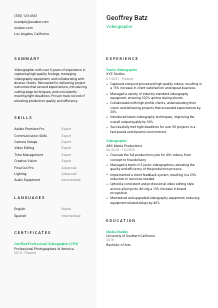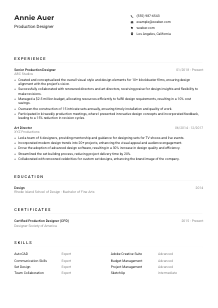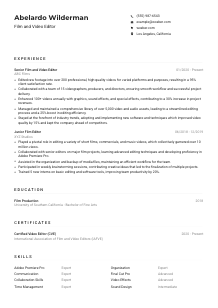Videographer Resume Example
Capturing life's moments, but your resume seems to be out of frame? Pan over this Videographer resume example, edited with Wozber free resume builder. See how smoothly you can align your visual storytelling skills with job expectations, making your career reel as captivating as your camera shots!

How to write a Videographer Resume?
Hello, aspiring Videographer! In a realm where visuals craft narratives and every frame speaks volumes, your resume must reflect the depth of your skills and the essence of your creativity. Using Wozber's free resume builder, we embark on a cinematic journey of tailoring your resume to perfectly align with your dream job's expectations. Imagine your resume as your personal highlight reel – let's ensure it's directed to captivate from the opening scene.
Personal Details
The camera starts rolling with your Personal Details. It's your opening shot, setting the stage for the narrative to unfold. Here's how to make sure this section demands a callback.
1. Lead with Your Name
Think of your name as the title of your personal film. It should be prominent, setting the tone for what follows. A slight increase in font size can ensure it catches the eye, much like a well-crafted opening title.
2. Job Title Precision
Directly beneath your name, include the job title "Videographer", as per the job description. This immediate alignment shows you're not just any applicant - you're here for this role, and this role specifically.
3. Contact Essentials
Your contact details are the call-to-action of this section. Ensure your phone number and professional email address (think firstname.lastname@email.com) are correct and ready for the director's call. Highlight your Los Angeles location, confirming your readiness to shoot on-site with no relocation delay.
4. Online Portfolio
A Videographer's resume without a link to their work is like a film without a teaser. Include your website or portfolio link, showcasing your best projects. This is your pitch, your chance to visually narrate your skills.
5. Cut the Clutter
Leave out personal trivia not related to the job. This helps keep the focus on your professional narrative and maintains a polished, ATS-compliant resume.
Takeaway
Set the tone with a compelling Personal Details section. It's your first impression, the greeting before the conversation. Keep it professional, aligned, and ready to lead into the story of you. This isn't just any resume; it's your storyboard for success.





Experience
The Experience section is the main act of your resume, trailing through your professional journey with the highlight reel of your most captivating projects and accomplishments. Let's make sure it's blockbuster material.
- Captured and post‑processed high‑quality videos, resulting in a 15% increase in client satisfaction and repeat business.
- Managed a variety of industry‑standard videography equipment, ensuring 100% uptime during shoots.
- Collaborated with high‑profile clients, understanding their vision and delivering projects that exceeded expectations by 20%.
- Introduced latest videography techniques, improving the overall output quality by 30%.
- Successfully met tight deadlines for over 50 projects in a fast‑paced and dynamic environment.
- Oversaw the full production cycle for 40+ videos, from concept to final delivery.
- Managed a team of 3 junior videographers, elevating the quality and efficiency of the production process.
- Implemented a client feedback system, resulting in a 25% reduction in revisions needed.
- Upheld a consistent and professional video editing style across all projects, driving a 10% increase in brand recognition.
- Maintained and upgraded videography equipment, reducing equipment‑related delays by 40%.
1. Scene Selection
Dissect the job description like a script, identifying key scenes where your experience intersects with the role's requirements. This close reading ensures your contributions align with what the director (hiring manager) is scouting for.
2. Credits Roll
Frame your professional chronology with precision. Lead with your latest role, detailing your title, the production house's name, and the dates you've contributed your art. This structured chronology tells the tale of your career's evolution.
3. Action Highlights
Craft bullet points that showcase your achievements and how they echo the job's script. Did you enhance client satisfaction with exceptional video editing? Quantify this with solid figures to magnify its impact, such as "Resulted in a 15% increase in client satisfaction."
4. Quantify Your Box Office Success
Numbers are the critics' reviews of your career. They validate the success of your projects and your capability to deliver. From the percentage of deadline success to project volume, make each number count.
5. Directing Focus
Concentrate on experiences directly related to the role of a Videographer. Sideline unrelated roles or tasks that don't contribute to the narrative you aim to portray. Every bullet point should scream action, aligning with the script provided by the job description.
Takeaway
Your Experience section is the climax of your story. It's where you depict not just what you've done, but how magnificently you've done it. Tailor it, make it quantifiable, and ensure each bullet point is a shot worth remembering. Your resume isn't just a document; it's a showcase reel waiting to be premiered.
Education
In the world of Videography, where continuous learning meets practical application, the Education segment of your resume can spotlight your foundational knowledge and commitment. Let's polish this scene to highlight your academic credentials.
1. Scripting Your Academic Background
Begin with the basics: your degree, the film school or institution you've graduated from, and the year of your matinee. While specific educational requirements weren't listed, showcasing a Bachelor of Arts in Media Studies from the University of Southern California aligns well with industry standards.
2. Setting the Stage
Keep your academic script clear and concise. This segment cues the hiring manager into your educational prowess, setting the scene for your technical and theoretical foundation in Videography.
3. Highlighting the Plot Twists
If your coursework directly bolstered your Videography skills, make a mention. Though not explicitly required, detailing relevant workshops or courses (for example, in advanced video editing) can add depth to your educational storyline.
4. Awards and Honors
Did your film win at a college festival? Were you recognized for your editing skills? Such accolades serve as rave reviews for your capabilities, showcasing your aptitude and passion for the craft.
5. Continuous Screenings
Your education doesn't end at graduation. Whether it's a workshop, an online course, or a seminar, continuous learning in your craft asserts your dedication to staying current and enhancing your skills.
Takeaway
Your Education section isn't just a formality; it's a testament to the foundation of your craft. Mold it to reflect the academic journey that has shaped your professional path, aligning with industry know-how and continuous learning. Your resume reflects your commitment to the art and science of Videography.
Certificates
In the ever-evolving field of Videography, certifications can be equivalent to film awards, highlighting your expertise and ongoing commitment. Let's frame this section to showcase your most spotlight-worthy achievements.
1. The Director's Cut
Identify the certifications that directly elevate your role as a Videographer. The Certified Professional Videographer (CPV) designation, for instance, directly underlines your authority and proficiency behind the camera.
2. Premieres
List certificates that are most relevant to Videography first. Prioritize those that enhance your skills in editing, camera work, or specific software proficiency – such as a mastery certificate in Adobe Premiere Pro.
3. Release Dates
Adding the acquisition date or expiration (if any) to your certificates can contextualize your achievements and signal your continuous engagement with the craft and its evolving technologies.
4. Upcoming Attractions
The world of Videography doesn't stand still, and neither should you. Stay proactive about acquiring new certifications that align with emerging technologies or techniques, ensuring your skills are always cutting-edge.
Takeaway
Each certificate you list is a laurel to your name, signaling to potential employers your commitment to staying at the forefront of Videography. Showcase these achievements with pride, as they add significant value to your portfolio and underscore your dedication to excellence.
Skills
The Skills segment is where your resume says ‘Action!' It speaks volumes about your proficiency in the essential tasks of a Videographer. Let's zoom in on how to optimize this section for a standing ovation.
1. Shot Composition
Break down the job requirements to identify must-have skills. In the example, proficiency in Adobe Premiere Pro, Final Cut Pro, and experience with multiple camera setups and lighting signal you're not just playing a part; you're leading the crew.
2. Framing
Prioritize and list skills that directly align with the job script. If you're an 'Expert' in Adobe Premiere Pro and have 'Advanced' skills in lighting, these distinctions set the stage for your depth of expertise, showcasing your technical prowess.
3. The Final Cut
While Versatility is key in Videography, resist the urge to list every skill in your arsenal. Concentrate on those in the spotlight for this role. This laser focus directs the hiring manager's attention to your most relevant abilities.
Takeaway
Treat the Skills section as the crescendo of your resume—the moment your capabilities are in full display. Curate it with precision, ensuring each skill listed is a testament to your ability to excel in the dynamic field of Videography. Let your expertise do the talking, and keep honing your craft for that perfect shot.
Languages
Communicating your language skills effectively is akin to choosing the right lens for a shoot; it can change the perspective drastically. Here's how to showcase your linguistic range, adding another dimension to your resume.
1. Script Analysis
Review the job description for any specific language requirements. The necessity for "Strong English communication skills" highlights the importance of being articulate in your primary medium of communication.
2. Language Tones
Position the essential languages for your role, such as English, at the pinnacle of your list, marked as 'Native' or 'Fluent.' This alignment immediately assures the director of your capability in the primary channel of communication.
3. Subtitles
Including other languages you're proficient in, such as 'Intermediate Spanish,' can illustrate your ability to work in diverse environments or international projects, broadening your appeal.
4. Authentic Dialogue
Be realistic about your proficiency levels. Overstating your fluency can lead to miscues when it's time to perform. Honesty in your skill level sets the right expectations and trust from the start.
5. Worldwide Release
For Videographers, especially those aiming to work in multicultural settings or global markets, showcasing additional languages can be a significant asset. It's a nod to your ability to capture and narrate stories from various cultural lenses.
Takeaway
Your ability to communicate in multiple languages is a compelling subplot in the story of your career. It represents an openness to diverse narratives and an ability to engage with a broader audience. Treat your linguistic skills as essential tools in your kit, ready to broaden the horizons of your professional journey.
Summary
The Summary is your trailer, capturing the essence of your story in a way that entices the hiring manager to see more. It's here that you lay the foundations of your narrative, setting the tone for the detailed story to follow.
1. The Pitch
Begin with an eye-catching overview that encapsulates your professional identity. "Videographer with over 5 years of experience" tells your audience not just who you are, but hints at the depth and breadth of your journey behind the lens.
2. Story Arc
Highlight key plot points that will resonate with the role's demands. Discuss your expertise with industry-standard videography equipment, your ability to deliver projects that exceed expectations, and your knack for introducing cutting-edge techniques.
3. Keep it Engaging
Remember, your summary is just that – a summary. Keep it concise yet compelling, much like a well-edited film trailer, capping it off with a glimpse of your ability to meet tight deadlines and elevate production quality.
4. Directing the Narrative
This section sets the scene for your resume. With every line, you're directing the hiring manager through the narrative of your career, ensuring they're hooked and eager to see your full feature – the rest of your resume.
Takeaway
Crafting an engaging summary is like setting up the opening scene of your favorite film: it has to grab attention, establish the tone, and make the audience want more. Think of it as your chance to preview your expertise, directly addressing the role's requirements. Pitch yourself as the ideal lead for the part, ready to bring your unique vision and skills to the role.
Curtain Call
And that's a wrap! You're now equipped with the director's vision for tailoring your Videographer resume, ensuring it's not only aligned with the job's script but poised to captivate from the get-go. Remember, your resume is your personal story, carefully edited to highlight your skills, experience, and the unique flair you bring to the role. Use Wozber's free resume builder, inclusive of ATS-friendly resume templates and an ATS resume scanner, to ensure your resume is not only a perfect fit for the role but also optimized for the digital stage.
Your next big role is just around the corner – let your resume be the ticket that gets you there. Lights, camera, action!

- Minimum of 3 years of professional experience in videography or a related field.
- Proficiency with industry-standard videography equipment, including multiple camera setups, lighting, and audio equipment.
- Strong working knowledge of video editing software such as Adobe Premiere Pro or Final Cut Pro.
- Ability to manage and meet deadlines in a fast-paced and dynamic environment.
- Excellent interpersonal and communication skills to collaborate with clients and team members.
- Strong English communication skills needed.
- Must be located in Los Angeles, California.
- Capture high-quality video footage for a variety of projects, including corporate videos, social media content, and promotional materials.
- Collaborate closely with clients or internal stakeholders to understand their vision and ensure deliverables align with their expectations.
- Edit and post-process videos, ensuring a consistent and professional style, and incorporating feedback from clients and team members.
- Stay up to date with the latest videography techniques and technologies to constantly improve the output quality.
- Manage and maintain videography equipment, ensuring it is in proper working condition for each shoot.















